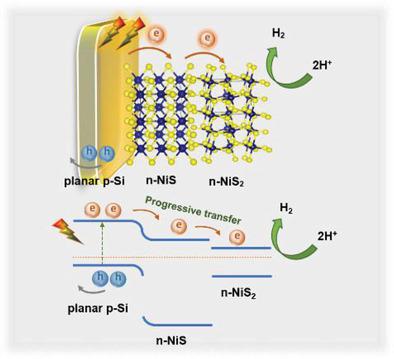当前位置:
X-MOL 学术
›
Small Methods
›
论文详情
Our official English website, www.x-mol.net, welcomes your
feedback! (Note: you will need to create a separate account there.)
Engineering Heterogeneous NiS2/NiS Cocatalysts with Progressive Electron Transfer from Planar p‐Si Photocathodes for Solar Hydrogen Evolution
Small Methods ( IF 10.7 ) Pub Date : 2021-01-18 , DOI: 10.1002/smtd.202001018 Sijie Li 1, 2 , Gaoliang Yang 1, 2 , Peng Ge 3 , Huiwen Lin 2, 4 , Qi Wang 1, 2 , Xiaohui Ren 1, 2 , Shunqin Luo 1, 2 , Davin Philo 1, 2 , Kun Chang 4 , Jinhua Ye 1, 2, 5
Small Methods ( IF 10.7 ) Pub Date : 2021-01-18 , DOI: 10.1002/smtd.202001018 Sijie Li 1, 2 , Gaoliang Yang 1, 2 , Peng Ge 3 , Huiwen Lin 2, 4 , Qi Wang 1, 2 , Xiaohui Ren 1, 2 , Shunqin Luo 1, 2 , Davin Philo 1, 2 , Kun Chang 4 , Jinhua Ye 1, 2, 5
Affiliation

|
The sluggish transfer of electrons from a planar p‐type Si (p‐Si) semiconductor to a cocatalyst restricts the activity of photoelectrochemical (PEC) hydrogen evolution. To overcome such inefficiency, an elegant interphase of the semiconductor/cocatalyst is generally necessary. Hence, in this work, a NiS2/NiS heterojunction (NNH) is prepared in situ and applied to a planar p‐Si substrate as a cocatalyst to achieve progressive electron transfer. The NNH/Si photocathode exhibits an onset potential of +0.28 V versus reversible hydrogen electrode (VRHE) and a photocurrent density of 18.9 mA·cm−2 at 0 VRHE, as well as a 0.9% half‐cell solar‐to‐hydrogen efficiency, which is much superior compared with those of NiS2/Si and NiS/Si photocathodes. The enhanced performance for NNH/Si is attributed to the contact between the sectional n‐type semiconducting NNH and the planar p‐Si semiconductor through a p‐Si/n‐NiS/n‐NiS2 manner that functions as a local pn‐junction to promote electron transfer. Thus, the photogenerated electron is transferred from p‐Si to n‐NiS within NNH as the progressive medium, followed by to Ni2+ and/or S22− of the defect‐rich n‐NiS2 phase as the key active sites. This systematic work may pave the way for planar Si‐based PEC applications of heterogeneous metal sulfide cocatalysts through the progressive transfer of electrons.
中文翻译:

设计具有来自平面 p-Si 光电阴极的渐进电子转移的多相 NiS2/NiS 助催化剂,用于太阳能析氢
电子从平面p型硅 ( p- Si) 半导体到助催化剂的缓慢转移限制了光电化学 (PEC) 析氢的活性。为了克服这种低效率,通常需要半导体/助催化剂的优雅界面。因此,在这项工作中,NiS 2 /NiS 异质结(NNH)被原位制备并作为助催化剂应用于平面p- Si 衬底以实现渐进式电子转移。NNH/Si 光电阴极相对于可逆氢电极 ( V RHE )的起始电位为 +0.28 V,在 0 V RHE 下的光电流密度为 18.9 mA·cm -2,以及 0.9% 的半电池太阳能到氢的效率,与 NiS 2 /Si 和 NiS/Si 光电阴极相比,这要优越得多。NNH/Si 的增强性能归因于截面n型半导体 NNH 与平面p- Si 半导体之间通过p -Si/ n -NiS/ n -NiS 2方式接触,起到局部pn结的作用促进电子转移。因此,光生电子从作为渐进介质的 NNH 中的p -Si转移到n -NiS,然后转移到 Ni 2+和/或 S 2 2-富含缺陷的n -NiS 2相作为关键活性位点。这项系统的工作可能通过电子的逐步转移为多相金属硫化物助催化剂的平面硅基 PEC 应用铺平道路。
更新日期:2021-01-18
中文翻译:

设计具有来自平面 p-Si 光电阴极的渐进电子转移的多相 NiS2/NiS 助催化剂,用于太阳能析氢
电子从平面p型硅 ( p- Si) 半导体到助催化剂的缓慢转移限制了光电化学 (PEC) 析氢的活性。为了克服这种低效率,通常需要半导体/助催化剂的优雅界面。因此,在这项工作中,NiS 2 /NiS 异质结(NNH)被原位制备并作为助催化剂应用于平面p- Si 衬底以实现渐进式电子转移。NNH/Si 光电阴极相对于可逆氢电极 ( V RHE )的起始电位为 +0.28 V,在 0 V RHE 下的光电流密度为 18.9 mA·cm -2,以及 0.9% 的半电池太阳能到氢的效率,与 NiS 2 /Si 和 NiS/Si 光电阴极相比,这要优越得多。NNH/Si 的增强性能归因于截面n型半导体 NNH 与平面p- Si 半导体之间通过p -Si/ n -NiS/ n -NiS 2方式接触,起到局部pn结的作用促进电子转移。因此,光生电子从作为渐进介质的 NNH 中的p -Si转移到n -NiS,然后转移到 Ni 2+和/或 S 2 2-富含缺陷的n -NiS 2相作为关键活性位点。这项系统的工作可能通过电子的逐步转移为多相金属硫化物助催化剂的平面硅基 PEC 应用铺平道路。











































 京公网安备 11010802027423号
京公网安备 11010802027423号